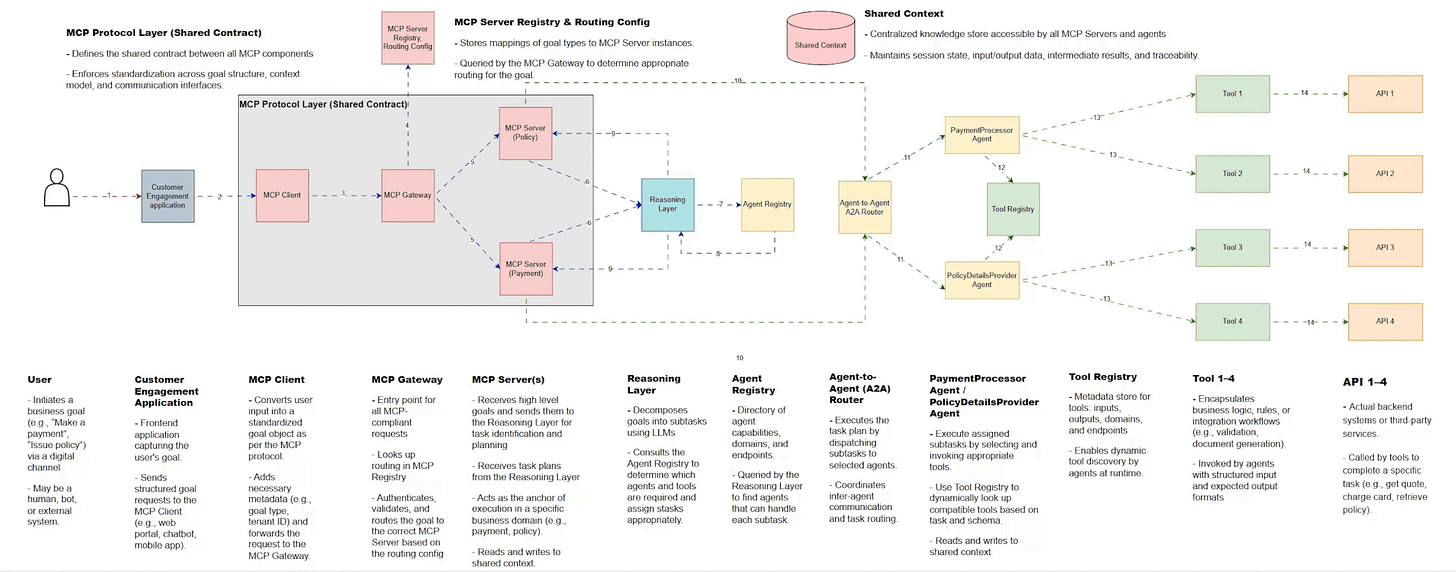Agentic AI Reference Architecture:
From Business Goals to Autonomous Execution
In my last post, we talked about why agents are the logical evolution beyond APIs. Now let’s go deeper into what that looks like in practice and how it actually works behind the scenes.
Here’s the Agentic AI Reference Architecture — a blueprint for how high-level goals turn into autonomous, traceable actions without hardcoded workflows.
Let’s walk through the journey from goal to execution:
👇 Take a look at the full architecture and detailed explanation below, and let me know — how would you build this in your org?
🧑💼 User
Initiates a business goal (e.g., “Make a payment”, “Issue policy”) via a digital channel
May be a human, bot, or external system
🔍 This is where it all begins — a clear business outcome is desired. What matters is that we treat this as a goal, not just an API request.
💬 Customer Engagement Application
Frontend application capturing the user's goal
Sends structured goal requests to the MCP Client (e.g., web portal, chatbot, mobile app)
🧭 This is the interface layer that bridges people and systems with the agentic backend. It doesn't handle logic — just captures intent and forwards it.
📦 MCP Client
Converts user input into a standardized goal object as per the MCP protocol
Adds necessary metadata (e.g., goal type) and forwards the request to the MCP Gateway
🧱 Think of the MCP Client as the translator between your application and your agentic infrastructure. It ensures all goals follow a consistent, composable structure.
🚪 MCP Gateway
Entry point for all MCP-compliant requests
Authenticates, validates, and routes the goal to the correct MCP Server based on the routing config
Looks up routing in the MCP Registry
🔒 This is where governance lives — it ensures requests are valid, secure, and routed to the right domain. It's like the traffic cop of your agentic platform.
🧠 MCP Server(s)
Receives high-level goals and sends them to the Reasoning Layer for task identification and planning
Receives task plans from the Reasoning Layer
Acts as the anchor of execution in a specific business domain (e.g., payment, policy)
Reads and writes to Shared Context
⚙️ The MCP Server orchestrates the full lifecycle of a goal. It delegates the thinking (reasoning) and doing (agents), while keeping track of the process and context.
🧩 Reasoning Layer
Decomposes goals into subtasks using LLMs
Consults the Agent Registry to determine which agents and tools are required and assigns tasks appropriately
🧠 This is the cognitive engine of the system. Instead of static workflows, it dynamically figures out what needs to happen — like a planner in your org with perfect memory and context.
🗂️ Agent Registry
Directory of agent capabilities, domains, and endpoints
Queried by the Reasoning Layer to find agents that can handle each subtask
📚 This registry allows for discovery and dynamic assignment. New agents can be added or updated without rewriting workflows — it's plug-and-play autonomy.
🔀 Agent-to-Agent (A2A) Router
Executes the task plan by dispatching subtasks to selected agents
Coordinates inter-agent communication and task routing
🔁 This router is what lets agents operate independently, but still in sync. It ensures that each agent gets the right job at the right time — and keeps the goal moving forward.
🤖 PaymentProcessor Agent / PolicyDetailsProvider Agent
Execute assigned subtasks by selecting and invoking appropriate tools
Use Tool Registry to dynamically look up compatible tools based on task and schema
Read and write to shared context
🎯 These agents are the executors. They don’t need to be told how to do things — just what needs to be done. They consult the registry and choose the right tool on their own.
🧰 Tool Registry
Metadata store for tools: inputs, outputs, domains, and endpoints
Enables dynamic tool discovery by agents at runtime
🔍 Agents don’t hardcode tool logic. They query this registry — just like we Google for answers — and get back the best tool for the task.
🛠️ Tool 1–4
Encapsulate business logic, rules, or integration workflows (e.g., validation, document generation)
Invoked by agents with structured input and expected output formats
🔧 These are your building blocks — tools that perform specific actions. Agents wrap these tools and invoke them on demand, just like how humans use apps to get things done.
🌐 API 1–4
Actual backend systems or third-party services
Called by tools to complete a specific task (e.g., get quote, charge card, retrieve policy)
🔗 These are the final legs of the journey — the systems that still do the heavy lifting. But now, instead of being directly triggered by UI code, they’re invoked autonomously through agents and tools.
✅ What Does This Architecture Enable?
✔️ Business goal in → Outcome out — with minimal human orchestration ✔️ No hardcoded workflows — just autonomous execution ✔️ Modular, composable, and easy to evolve ✔️ Full traceability via shared context
This is how enterprises can evolve from API-first to agent-first execution — where systems don't just expose functionality, they drive results.
#AgenticAI #EnterpriseArchitecture #AIinBusiness #LLM #AutonomousExecution #DigitalTransformation #FutureOfWork


